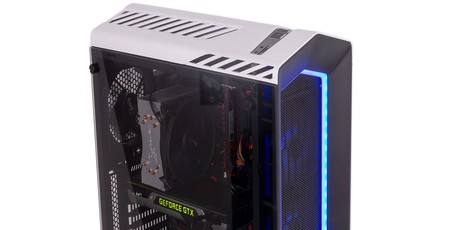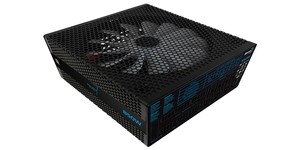
Interior
Four thumbscrews hold the tempered glass side panel in place, while the opposite one relies on notches and rails, which does feel a little tired in a £100+ chassis. Nonetheless, it’s easy to get inside, and once there you’ll find the usual PSU shroud dividing the case into two main segments. While the layout is familiar and user-friendly, some elements are a bit of a letdown: Only some motherboard mounts are pre-installed, for instance, and the expansion slot covers have that older design where they have to be bent and broken off, while the PSU rests on foam rather than rubber. With the thin steel as well, the P7-C1 Pro starts to feel a little like an inexpensive core chassis that’s been dressed up with a fancy exterior.


Functionally, at least, things are positive. There’s ample room for installing your core hardware, and the build process is easy. For storage, a two-bay HDD cage is fitted in the lower section, attached to the PSU cover by four screws that allow it to be removed. The mounting trays themselves are plastic and a bit flimsy, but they do come with rubber grommets and work fine.

There are two metal 2.5” mounting trays on the PSU cover and another two behind the front of the elongated motherboard tray, each one secured to the chassis with a single thumbscrew. One small issue is that the rails used to align them are blocked out whenever you have a drive in place.




Sadly, it's not immediately obvious where you’re supposed to mount the controller. It does fit snugly into the 2.5” mounting trays, and we managed to screw it in from beneath, but it’s not made clear in the manual. It also makes it quite a tight fit for a couple of the connectors. The P7-H1 is a product sold separately to this case, so we’re not saying it should be integrated (although this would be preferred), but a bit of extra thought as to how it fits in with the P7-C1 would have been nice.


Ultimately, we were able to connect the four case fans and the four RGB headers (three from the front fans, one from the front panel lighting) to the P7-H1 and keep the cabling from spilling into unsightly areas, but there’s room for improvement. One thing to take note of is that with the two USB 2.0 ports on the front panel, the SD card reader, and the hub, this case is effectively asking for three USB 2.0 headers – not such a common sight on motherboards these days. The LED control software is simple to use at least, with enough effects to keep most happy. Alternatively, as mentioned, you can connect it to an RGB header on your MSI, Gigabyte, or Asus motherboard and use the manufacturer's software to control it as part of your system-wide RGB lighting.


The SSD mounting point behind the motherboard tray also acts as the main cable routing point. The case comes with four Velcro cable ties for you to use wherever you see fit, with a smattering of anchor points in the usual locations. The depth differential between the motherboard tray and the front tray creates the primary hole through which cables are routed into the main cavity. There are also holes above the motherboard, although you only get one serving both SSDs on the PSU cover. You also lack a dedicated hole for PCIe cables, and grommets aren’t used anywhere (though arguably they’re not needed).

You can fit 240mm radiators in the roof and 280mm or 360mm radiators in the front, although you’ll be limited to slimline models and a single row of fans in both instances. The focus seems to be all-in-one coolers, but there’s probably room for a custom loop as well.

MSI MPG Velox 100R Chassis Review
October 14 2021 | 15:04








Want to comment? Please log in.